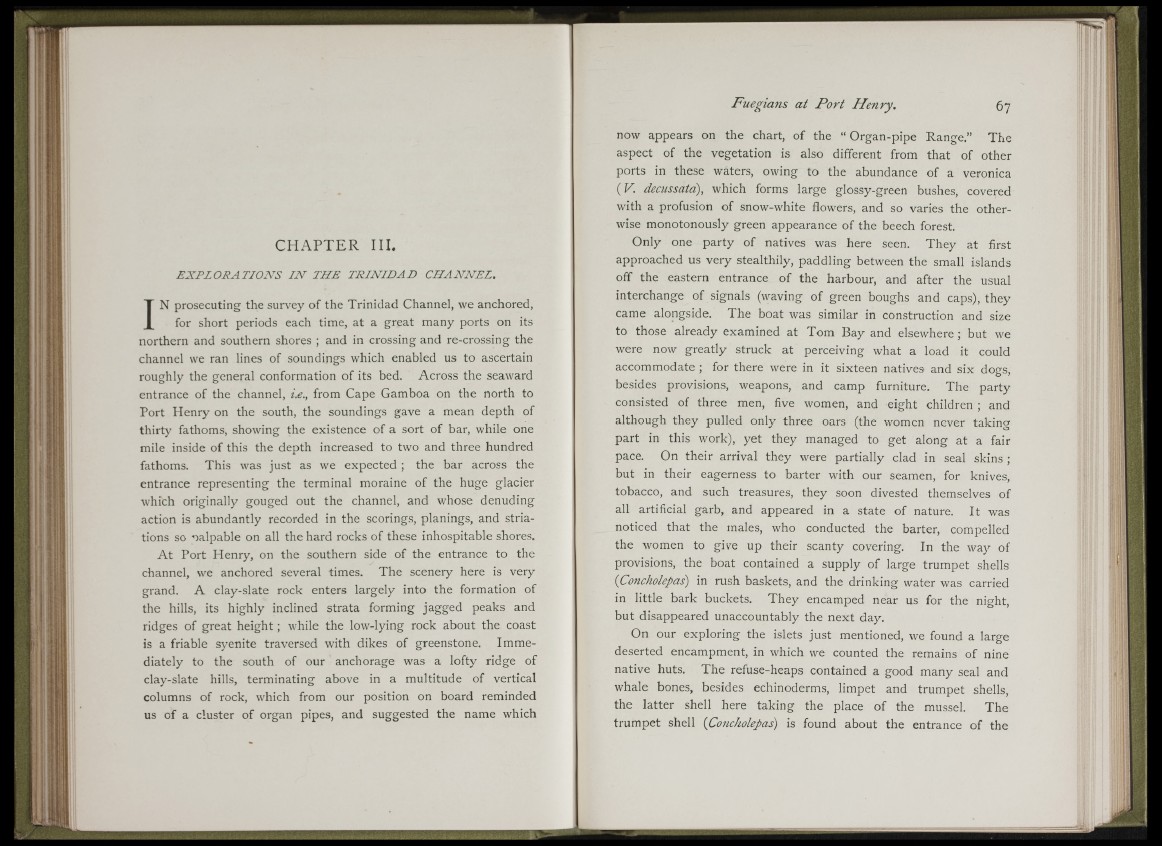
Fuegians at Port Henry.
CHAPTER III.
E X P L O R A T IO N S I N TH E T R IN ID A D CH A N N E L .
I N prosecuting the survey of the Trinidad Channel, we anchored,
for short periods each time, at a great many ports on its
northern and southern shores ; and in crossing and re-crossing the
channel we ran lines of soundings which enabled us to ascertain
roughly the general conformation of its bed. Across the seaward
entrance of the channel, i.e., from Cape Gamboa on the north to
Port Henry on the south, the soundings gave a mean depth of
thirty fathoms, showing the existence of a sort of bar, while one
mile inside of this the depth increased to two and three hundred
fathoms. This was just as we expected ; the bar across the
entrance representing the terminal moraine of the huge glacier
which originally gouged out the channel, and whose denuding
action is abundantly recorded in the scorings, planings, and stria-
tions so nalpable on all the hard rocks of these inhospitable shores.
At Port Henry, on the southern side of the entrance to the
channel, we anchored several times. The scenery here is very
grand. A clay-slate rock enters largely into the formation of
the hills, its highly inclined strata forming jagged peaks and
ridges of great height ; while the low-lying rock about the coast
is a friable syenite traversed with dikes of greenstone. Immediately
to the south of our anchorage was a lofty ridge of
clay-slate hills, terminating above in a multitude of vertical
columns of rock, which from our position on board reminded
us of a cluster of organ pipes, and suggested the name which
now appears on the chart, of the “ Organ-pipe Range.” The
aspect of the vegetation is also different from that of other
ports in these waters, owing to the abundance of a veronica
( V. decussata), which forms large glossy-green bushes, covered
with a profusion of snow-white flowers, and so varies the otherwise
monotonously green appearance of the beech forest.
Only one party of natives was here seen. They at first
approached us very stealthily, paddling between the small islands
off the eastern entrance of the harbour, and after the usual
interchange of signals (waving of green boughs and caps), they
came alongside. The boat was similar in construction and size
to those already examined at Tom Bay and elsewhere; but we
were now greatly struck at perceiving what a load it could
accommodate ; for there were in it sixteen natives and six dogs,
besides provisions, weapons, and camp furniture. The party
consisted of three men, five women, and eight children; and
although they pulled only three oars (the women never taking
part in this work), yet they managed to get along at a fair
pace. On their arrival they were partially clad in seal skins;
but in their eagerness to barter with our seamen, for knives,
tobacco, and such treasures, they soon divested themselves of
all artificial garb, and appeared in a state of nature. It was
noticed that the males, who conducted the barter, compelled
the women to give up their scanty covering. In the way of
provisions, the boat contained a supply of large trumpet shells
{Concholepas) in rush baskets, and the drinking water was carried
in little bark buckets. They encamped near us for the night,
but disappeared unaccountably the next day.
On our exploring the islets just mentioned, we found a large
deserted encampment, in which we counted the remains of nine
native huts. The refuse-heaps contained a good many seal and
whale bones, besides echinoderms, limpet and trumpet shells,
the latter shell here taking the place of the mussel. The
trumpet shell {Concholepas) is found about the entrance of the
L...
l!4.: